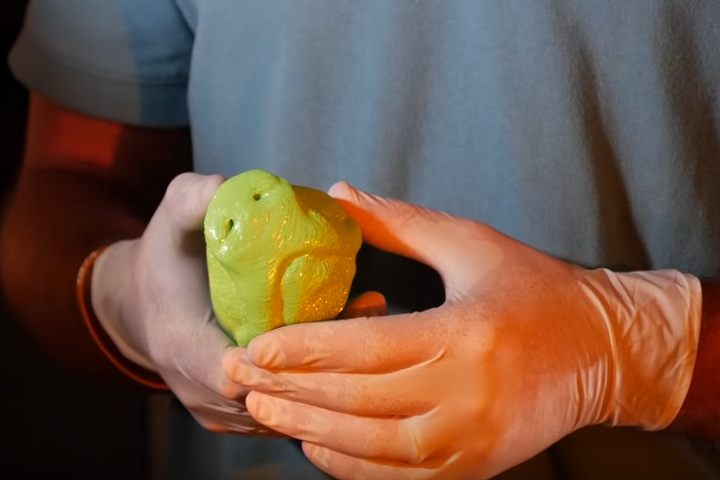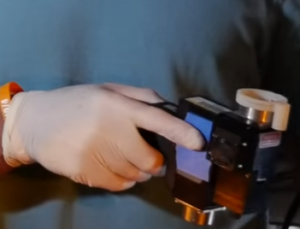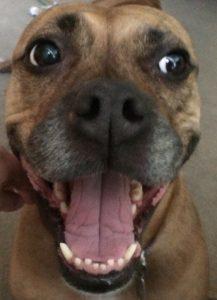My dogs go crazy when we bring Chinese food home, because they can smell the wontons my husband will eventually feed them. They won’t give him any peace until he finally deposits said wontons into their bowls (note, we rarely give them ‘people food,’ but wontons are a special exception). We all know dogs have an incredible sense of smell; it’s their own animal superpower, like the way a cat’s tongue works is unique to cats.
A dog’s nose isn’t just a wonton-detector, though – dogs have been trained to sniff out all sorts of things, like bombs, drugs, and other contraband. Humans have been trying to harness the power of a dog’s nose for a long time, but even the best electronic scent-detection devices, which try to emulate dog noses, aren’t quite up to snuff. But new research involving a 3D printed dog nose is being used to improve drug and bomb detectors.
A dog’s nose contains almost 300 million smell receptors. Compare that to the mere six million smell receptors a human nose has, and it’s no wonder that a dog’s sense of smell is over 40 times better than ours. Biomimicry is the study of nature to find solutions for human technical problems. Matthew Staymates, a mechanical engineer and fluid dynamicist with the National Institute of Standards and Technology (NIST) was the lead author on a recently published paper that offers new insight into how a dog’s nose works, and how it can be applied to modern detection equipment. Working with other NIST colleagues, the U.S. Food and Drug Administration, and the Massachusetts Institute of Technology’s Lincoln Laboratory, Staymates thought that the fascinating sniffing skills of the canine snout had something to do with its anatomy.
 Staymates used a Stratasys digital materials 3D printer, from the Connex series, to print out a replica of a female Labrador retriever’s nose. He worked on some modifications, attached it to an electronic detector, and voila: a fully functioning, anatomically correct dog’s nose that sniffs just like a real canine! He then used high-speed video and a device called a schlieren optical system, which is used often in aeronautical engineering to watch the flow of air around objects, to view the air going in and out of a dog’s nose when it’s snuffling around on the ground. So what’s the key to a dog’s sense of smell? It doesn’t have much to do with the amount of brain space dedicated to scent, or even the number of sensing cells a dog has, but rather the anatomy of how the air flows in and out of a dog’s nostrils.
Staymates used a Stratasys digital materials 3D printer, from the Connex series, to print out a replica of a female Labrador retriever’s nose. He worked on some modifications, attached it to an electronic detector, and voila: a fully functioning, anatomically correct dog’s nose that sniffs just like a real canine! He then used high-speed video and a device called a schlieren optical system, which is used often in aeronautical engineering to watch the flow of air around objects, to view the air going in and out of a dog’s nose when it’s snuffling around on the ground. So what’s the key to a dog’s sense of smell? It doesn’t have much to do with the amount of brain space dedicated to scent, or even the number of sensing cells a dog has, but rather the anatomy of how the air flows in and out of a dog’s nostrils.
 When a dog exhales, a turbulent jet of air comes out of each nostril, just like with a human’s nose. But the way dogs, and their noses, are positioned on the ground means those exhaled air jets are directed, or vectored, down towards their rear. Fluid dynamics says that vectoring air backward also causes the air to be pulled forward, meaning that the air in front of a dog is pulled into his nose while he’s exhaling the air previously pulled in.
When a dog exhales, a turbulent jet of air comes out of each nostril, just like with a human’s nose. But the way dogs, and their noses, are positioned on the ground means those exhaled air jets are directed, or vectored, down towards their rear. Fluid dynamics says that vectoring air backward also causes the air to be pulled forward, meaning that the air in front of a dog is pulled into his nose while he’s exhaling the air previously pulled in.
“He’s kind of reaching out and pulling a new plug of fresh air from ahead of himself,” said Staymates. “He inhales it then immediately and he analyzes it with a pretty amazing chemical detector. And he does this about five times a second.”
 This means that dogs can sniff a larger environment, and also know the direction of where a scent is coming from. This research into a dog’s amazing olfactory abilities is already being put to good use. Staymates and his team have created prototypes that are already being added to commercially available bomb and narcotics detectors. The upgraded equipment works up to 18 times better than the ones that haven’t been ‘doggy-fied’!
This means that dogs can sniff a larger environment, and also know the direction of where a scent is coming from. This research into a dog’s amazing olfactory abilities is already being put to good use. Staymates and his team have created prototypes that are already being added to commercially available bomb and narcotics detectors. The upgraded equipment works up to 18 times better than the ones that haven’t been ‘doggy-fied’!
Additional upgrades may include incorporating more bio-inspired design principles to the new detectors, including the use of heated air jets during the sniffing. Just think, it only took a great idea, optical imaging, and 3D printing to upgrade the devices that help keep us safe at airports. This is definitely not the first time that 3D printing and the animal kingdom have combined to make our lives better, and it certainly won’t be the last.
Here’s a video of Staymates explaining how a dog’s nose really works:
Discuss in the 3D Printed Dog Nose forum at 3DPB.com.
[ISource: CBC News / NIST]
Subscribe to Our Email Newsletter
Stay up-to-date on all the latest news from the 3D printing industry and receive information and offers from third party vendors.
You May Also Like
Visages Launches 3D Printed Glasses Line
French startup Visages has released a service that lets you customize your own glasses, which are then produced on demand using eco-friendly materials. The company aims to be a digital...
Materialise Empowers 3D Printing with New Innovations and Alliances at RAPID+TCT 2024
Materialise (Nasdaq: MTLS) kicked off RAPID + TCT 2024 in Los Angeles by unveiling upgrades to its flagship preparation software, Magics, and announcing new partnerships with Ansys, nTop, and EOS....
Printing Money Episode 19: Q1 Earnings Analysis with Troy Jensen, Cantor Fitzgerald
We are back with Episode 19 of Printing Money. The world does not stop turning. One not-so-profound reminder of that is the quarterly earnings reports of publicly traded companies. It...
nTop Launches Version 5 of its 3D Modeling Software at RAPID + TCT 2024
nTop, the NYC-based provider of design software used for additive manufacturing (AM), has launched nTop 5, the latest version of its flagship platform, ahead of RAPID + TCT 2024 in...
































